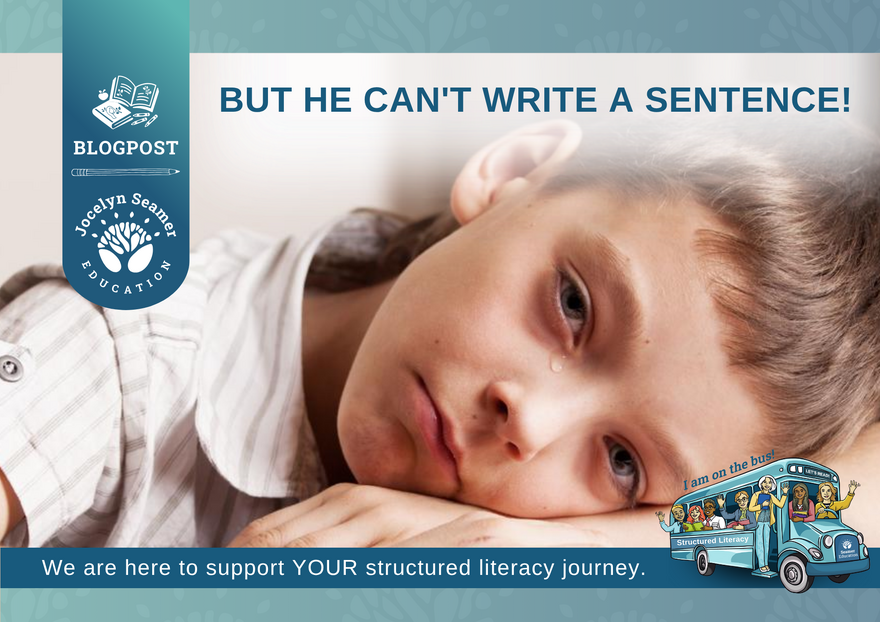But He Can't Write A Sentence!

In preparation for my new Teach Along – Writing Success in the Early Primary Years – I talked to quite a few teachers to really understand what it is they experienced when teaching writing. There were many things they had in common, and one of them was this statement:
“I am expected to get all children writing full texts, when some of them can’t even write a sentence. It just doesn’t make sense!
As I spoke with them, I could hear the frustration and worry in their voices. Frustration that their leaders didn’t ‘get’ what was really happening in their classrooms. Frustration that they have been so poorly prepared and supported to teach writing. Worry that they were letting their students down, but also worry that they might not have the teaching goods to help their students grow their skills. Our profession is called a caring profession for a reason. When we care about our students, the idea that we might not be able to make a positive difference is a crumby one.
So, this post is an attempt to inject some common sense in the conversation about teaching writing and a suggestion for how you can navigate that tricky tightrope of meeting both your school expectations and the needs of your students.
1) Meet students where they are up to
That feeling we have that it doesn’t make sense to ask students to write full texts before they are actually able to is spot on. After all, we don’t give children chapter books to read before they can read sentences. To make sure you have realistic expectations for students, complete a student skills audit for your class. Note down the independent writing level of your students. That means, the level can they write with confidence with no help or scaffolding from you. This will give you a profile of your class.

2) Set Ambitious Expectations for Learning
Once you have ascertained what level of writing you can reasonably expect from students, you can adjust the way you engage them in writing across the curriculum. This doesn’t mean that if children can only write words, you only have them work at word level. It is important that all students in your class receive instruction in all areas of the curriculum that is appropriate for their grade. English (the language and literature components), HASS, Science, Health, Arts and Technologies should include exposure to texts and content that extends students language learning and concept development. That means that ALL children participate in lessons orally with partner work and scaffolded opportunities to learn the language needed to express what they know, but when it comes to actually writing, you only expect the student to physically write what they can. Of course this means providing alternative assessment opportunities for students who need it.
3) Aim for more
It isn’t enough to simply accept that not all students can write. It is necessary to reflect on how you are supporting students to develop skills in the ‘next box along’. If students are currently not writing words, how are you teaching them to do so? If they can, how are you explicitly supporting them to write a simple sentence? Think about the fact that students need you to teach these skills systematically and explicitly. It is not effective to rely on independent activities in a rotation or context embedded learning to develop these skills.

Where you can you fit this in?
Word level transcription – daily phonics lesson
Simple sentence level writing – gradual release transcription activity related to the decodable texts students are reading
More advanced sentences – taught during language and literature lessons and practiced to achieve fluency in morning routine & related to the decodable texts students are reading.
4) Be intentional with scaffolding and support
Finally, think about how you are supporting students TO learn to write those full texts. Here are some suggestions:
- Make sure you give children ample opportunity to learn about the content of what you want them to write.
- Provide hands on opportunities if you can.
- ALWAYS model the language you want children to use and then give them lots of time to talk with a partner before writing.
- Break the writing down into small components for children who need it and go through the ‘I do, we do, you do’ for each section of the text. This means that it might take 3 days to write three paragraphs, but if that’s what it takes, that’s what it takes.
- Make sure that the ‘we do’ is a full participation part of your lesson. It isn’t enough to have you and 4 of your 25 students work on a piece. EVERY child needs to be a part of the joint construction.

A common-sense approach to writing instruction does not have to mean you abandon everything you every done in this area, but it does mean closely matching student current levels of transcription with your expectations. Once you gain clarity about where students are up to and where they are headed, you can tailor instruction to suit their learning needs.

 Jocelyn Seamer Education
Jocelyn Seamer Education
2 comments
Wow, Thankyou Jocelyn I love this. Is there a word copy or PDF of the Planning Template?
Good Article to read. Thanks to writer
Leave a comment